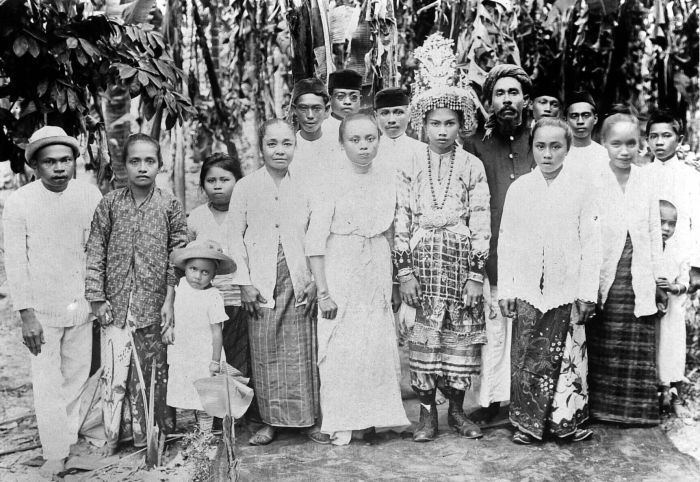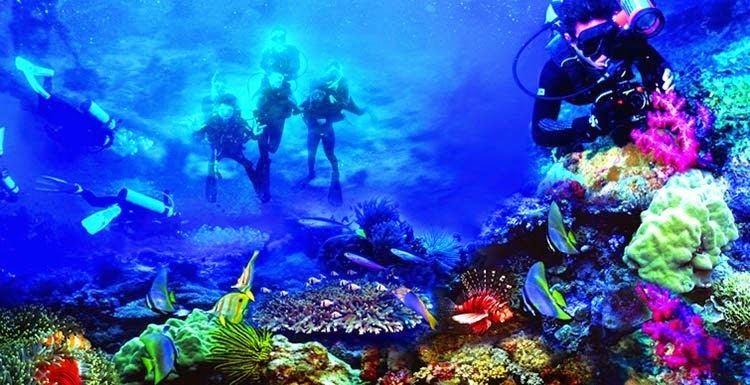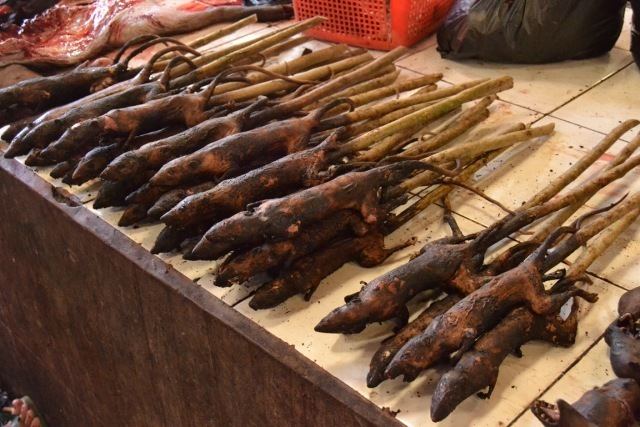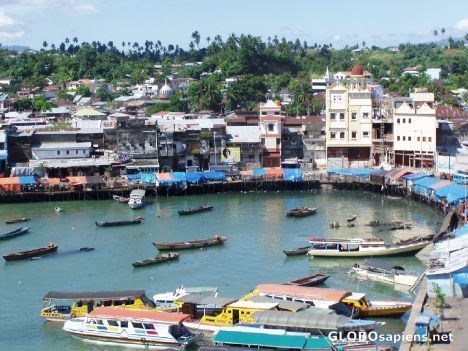Country Indonesia | Population 410,481 (2010) Area 166.87 km2 Mayor G. S. Vicky Lumentut | |
 | ||
Colleges and Universities Sam Ratulangi University, Manado State University, De La Salle Catholic University - Manado, Mount Klabat College | ||
Map of Manado
Manado (pronounced [maˈnado] in Manado Malay, [məˈnado] in Indonesian) is the capital city of the North Sulawesi province of Indonesia. Manado is located at the Bay of Manado, and is surrounded by a mountainous area. The city had 675,411 inhabitants at the 2010 Census, making it the second-largest city in Sulawesi after Makassar. The latest official estimate (for January 2014) is 701,390.
Contents
- Map of Manado
- Lumbalumba diving manado north sulawesihttpwww youtube com
- Sma n 7 manado dbl sulut 2015 final party dbl 140215
- Etymology
- History
- Geography
- Administration
- Ethnicity and Languages
- Religion
- Transportation
- Main sights
- Tourism
- Cuisine
- Sister cities
- Language
- Notable people
- References

Lumbalumba diving manado north sulawesihttpwww youtube com
Sma n 7 manado dbl sulut 2015 final party dbl 140215
Etymology

The name Manado, which is derived from the Minahasan Language, comes from manadou or wanazou meaning "on the far coast" or "in the distance" and originally referred to the further of two islands which can be seen from the mainland. When the settlement on this island was relocated to the mainland, the name Manado was brought with it, after which the island itself became referred to as Manado Tua ("Old Manado"). The name for Manado in the Sangir language is Manaro.
History

The first mention of Manado comes from a world map by French cartographer Nicolas Desliens, which shows the island of Manarow (today's Manado Tua). Before Europeans arrived in North Sulawesi, the area was under the rule of the Sultan of Ternate, who exacted tribute and introduced the Muslim religion among some of its inhabitants. The Portuguese made the Sultan their vassal, taking possession of the Minahasa and establishing a factory in Wenang.
Meanwhile, the Spanish had already set themselves up in the Philippines and Minahasa was used to plant coffee that came from South America because of its rich soil. Manado was further developed by Spain as a center of commerce for the Chinese traders who traded the coffee in China. With the help of native allies the Spanish took over the Portuguese fortress in Amurang in the 1550s and Spanish settlers also established a fort at Manado so that eventually Spain controlled all of the Minahasa. It was in Manado where one of the first Indo-Eurasian (Mestizo) communities in the archipelago developed during the 16th century. The first King of Manado (1630) named Muntu Untu was in fact the son of a Spanish Mestizo.
Spain renounced to her possessions in Minahasa by means of a treaty with the Portuguese in return for a payment of 350,000 ducats. Minahasan natives made an alliance treaty with the Dutch and expelled the last of the Portuguese from Manado a few years later.
The Dutch East India Company or Verenigde Oost Indische Compagnie (VOC) built a fortress in Manado named Fort Amsterdam in 1658. As with regions in eastern Indonesia, Manado has undergone Christianization by Dutch missionaries, including Riedel and John Gottlieb Schwarz. The Dutch missionaries built the first Christian church in Manado called Oude Kerk (Old church), which still stands and is now called Gereja Sentrum. The HMS Dover captured Manado in June 1810. The Javanese prince Diponegoro was exiled to Manado by the Dutch government in 1830 for leading a war of rebellion against the Dutch. In 1859, the English biologist Alfred Wallace visited Manado and praised the town for its beauty.
In 1919, the Apostolic Prefecture of Celebes was established in the city. In 1961, it was promoted as the Diocese of Manado.
The Japanese captured Manado in the Battle of Manado in January 1942. The city was heavily damaged by Allied bombing during World War II.
In 1958, the headquarters of the rebel movement Permesta was moved to Manado. When Permesta confronted the central government with demands for political, economic and regional reform, Jakarta responded by bombing the city in February 1958, and then invading in June 1958.
Geography
Manado experiences tropical rainforest climate (Af) according to Köppen Climate Classification as there's no real dry season. The wettest month is January with an annual precipitation of 465 millimetres (18.3 in), while the driest is September with an annual precipitation of 121 millimetres (4.8 in). The abundance of total precipitation seems to be influenced by the monsoon. As its location is near the equator, the temperature seems constant throughout the year. The hottest month is August with an average temperature of 26.6 °C (79.9 °F), while the coolest month are January and February with an average temperature of 25.4 °C (77.7 °F). Unlike other cities in Indonesia, the temperature seems to be cooler.
Administration
The city is divided into 11 districts (kecamatan). The table below lists population totals from the 2010 Census. It does not include the districts of Bunaken Kepulauan and Paal 2, which were established in 2012.
The boundaries of Manado City are as follows:
Ethnicity and Languages
Currently the majority of Manado city residents are from the Minahasa, because Manado is located in Minahasa land. The indigenous people of Manado are sub Tombulu sub-tribes seen from several urban villages in Manado from Tombulu language, for example: Wenang (Wenang / Mahawenang - kolintang), Tumumpa (down), Mahakeret (yelling), Tikala Ares (Walak Ares Tombulu, where the word 'ares' means punishable), Ranotana (ground water), Winangun (built), Wawonasa (wawoinasa - above sharpened), Pinaesaan (unity place), Pakowa (Tree of Treasure), Teling ( Fur / bamboo to make equipment), Titiwungen (excavated), Tuminting (from the word Ting-Ting: The bell, the word insert -um- means showing the verb, so Tuminting: Ringing Bell), Pondol (Edge), Wanea (from word Wanua: meaning the country), etc .; While the Malalayang area is Bantik tribe, other tribes in Manado today are Sangir tribe, Gorontalo tribe, Mongondow tribe, Arabian tribe, Babontehu tribe, Talaud, Tionudese, Siau] and the Borgo. Due to the large number of Arabian peranakan communities, the existence of the Kampung Arab which is within a radius near Pasar '45 still survives until now and became one of the religious tourism destinations. In addition, there are also residents of Javanese, Chinese, Batak, Makassar and Moluccans people, the small Jewish community are also exist.
Minahasan languages is main language spoken in Manado. Manado language resembles Malay and Indonesian but with a distinctive accent. Some of the loan words in the Minahasan dialect are from Dutch, Portuguese and other foreign languages.
Religion
Christianity is the major religion in Manado, constituting around 67 percent of all residents, Islam comes second forming about 30 percent and the rest follow Buddhism, Hindusim and Confucianism, according to the 2010 national census. Even so heterogeneous, but the people of Manado really appreciate the attitude of tolerant, harmonious, open and dynamic life. Therefore the city of Manado has a relatively conducive social environment and is known as one of the relatively safe cities in Indonesia. When Indonesia was vulnerable to political upheaval around the year 1999 and riots hit cities in Indonesia. Manado city can be said to be relatively safe. This is reflected from the slogan of the people of Manado namely Torang samua basudara which means We are all brothers.
Transportation
Sam Ratulangi International Airport of Manado is one of the main entry ports to Indonesia. In 2005, no fewer than 15,000 international passengers entered Indonesia via the city's airport, its connected to several Indonesian cities such as Jakarta, Surabaya, Makassar, and others. Other public transportation in Manado are:
- Trans Kawanua (Bus)
- Damri Busses serving Airport to Downtown Manado
- Bus serving Tomohon to Manado
Terminal Malalayang or Malalayang Bus Terminal serves as the main gateway for long-distance buses in Manado.
Main sights
Manado is home to some of the biggest and most influential churches in the province, with many of them located along the iconic Sam Ratulangi Street.
Tourism
Cuisine
Food that typical of Manado are, Tinutuan which consists of various kinds of vegetables. Tinutuan is not mush, as so far people have said it as Manado porridge. In addition to Tinutuan, there is Cakalang Fufu, a smoked skipjack ('Katsuwonus pelamis'), roa fish (exocoetidae or torani; Parexocoetus brachypterus), Kawok which is food based from rat meat of forest / White (Maxomys hellwandii); Paniki (meat-based dishes bat; Pteropus pumilus) and RW ( abbreviated of Rinte Wuuk) is local name of the dog meat, Swine pig (1 pig is burnt by rotating on the embers), usually served at parties, Babi Putar (made from pork mixed with manado spices and rolled burned in bamboo). There is also a typical drink from the area of Manado and its surroundings are saguer which is a kind of wine or palm wine derived from enau / aren tree ( Arenga pinnata) which is then fermented. This saguer has an alcohol content, Cap Tikus (high alcoholic beverage with 40% more ethyl alcohol content derived from saguer distillation process).
Woku is a type of bumbu (spice mixture) found in Manado cuisine of North Sulawesi, Indonesia. It has rich aroma and spicy taste. Woku consist of ground spices paste; red ginger, turmeric, candlenut and red chili pepper, mixed with chopped shallot, scallion, tomato, lemon or citrus leaf and turmeric leaf, lemon basil leaf and bruised lemongrass. Rub main ingredients (chicken or fish) with salt and lime juices, and marinate for 30 minutes. All spices are cooked in coconut oil until the aroma came up and mixed together with the main ingredients, water, and a pinch of salt, well until all cooked well.
Other typical food of Manado city which is also quite famous is Nasi Kuning which taste and its presentation is different from yellow rice in other area because it is spiked with abon of cakalang rica fish and presented in parcel using sugar palm leaves. In addition there are also grilled fish roasted head. Dabu-dabu is a very popular typical of Manado sauce, made from a mixture of red chillies, cayenne pepper, sliced red onion and freshly diced tomatoes and finally given a mixture of soy sauce.
Sister cities
Language
The local language spoken in Manado and the surrounding area is a creole of the Malay language called Manado Malay.
